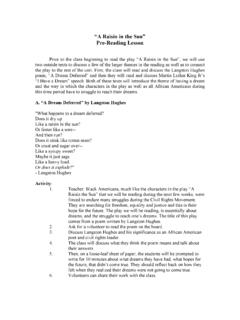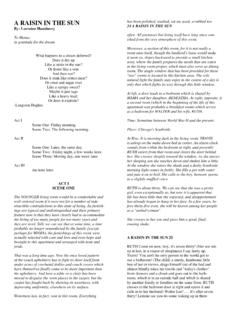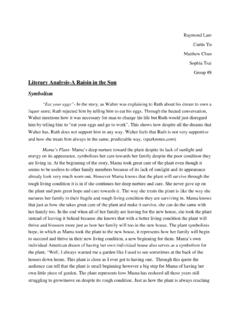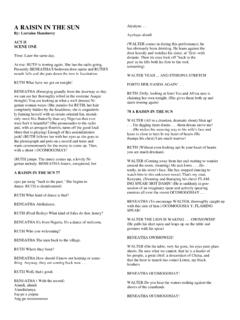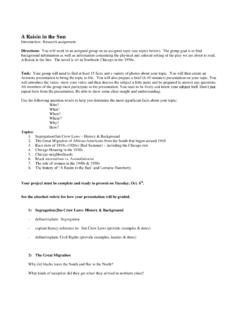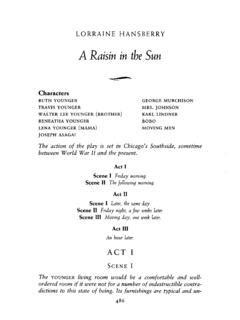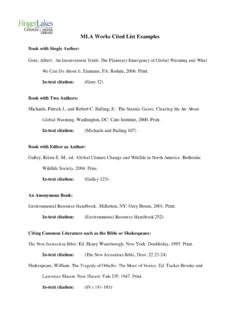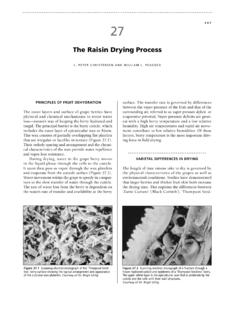Transcription of Raisin Grape Varieties - University of California, Davis
1 Thompson Seedless is the dominant Raisin variety grown in California because of its high productivity, wide soil adaptability, seedless fruit, and versatility for use in different Grape and Raisin products. About 95 percent of California raisins are currently pro-duced from Thompson Seedless grapes, followed by Fiesta (3 percent) and Zante Currant ( percent). The remainder are produced from DOVine, Muscat of Alexandria, Sultana (false Sultanina ), Monuk-ka, Ruby Seedless, Flame Seedless, and Perlette. Thompson Seedless is also dominant in most com-mercial Raisin -producing countries worldwide. Thompson Seedless has not always been the fore-most Raisin variety in California plantings. Muscat of Alexandria was the first Raisin variety introduced into California, and it dominated for about 40 years until the early 1920s.
2 In 1913, about 75 percent of Califor-nia s raisins were Muscat of Alexandria and only 14 percent were Thompson Seedless. By 1925 the posi-tions of the two Varieties was reversed, with Thomp-son Seedless constituting 80 percent and Muscat of Alexandria 15 percent of California Raisin production. This shift was in response to a rapidly growing prefer-ence for seedless , the Raisin industry has relied almost entirely on Old World Grape Varieties . There was little interest in the development of new Varieties until the breeding and introduction of Fiesta by John Wein-berger of the USDA Agricultural Research Service in 1973. The principal advantage of Fiesta is that it typi-cally ripens about 10 to 14 days ahead of Thompson Seedless and has high-quality, meaty raisins .
3 Its early ripening allows growers to begin harvesting earlier, and that reduces the risk of damage from early rainfall and extends the picking period for farm laborers. New plantings of Fiesta were interrupted for a few years after the variety was introduced, due to concerns over the presence of seed traces in the berries. The perceived seed trace problem has since waned; Fiesta raisins are now widely accepted by Raisin packers and the variety has gradually grown in importance. Interest in new Varieties has increased as a result of the acceptability of Fiesta and the recognized need for earlier-ripening, high-quality Varieties . Seedlessness (seed traces of Thompson Seedless size or smaller), early ripening, potential for drying on the vine (DOV), suitability for mechanized pruning or harvesting operations, and tolerance to important pests and dis-eases are other characteristics of interest to develop-ers of new Raisin Varieties .
4 DOVine was introduced by USDA in 1995 because of its suitability for DOV with cane cutting. Its early ripening, adaptability for cane pruning, and high Raisin quality characteristics give DOVine the potential for earlier cane cutting for DOV with improved Raisin quality. The future development of new Varieties has the potential to revolutionize rai-sin production, drying, and harvesting practices. ThOMPsOn s eedless Origin Thompson Seedless (Plate ) is thought to have originated in Persia in Asia Minor, in an area that now makes up parts of Iran and Turkey. Its use spread throughout Asia Minor, the Mediterranean, northern Africa, and then to Europe, and it was from Europe that it came to America, South Africa, and Australia. The variety was introduced into California in 1872 by William Thompson of Yuba City.
5 Thompson acquired cuttings from the Elwanger and Barry nursery of Roch-ester, New York, which described the variety as a Grape from Constantinople grown in English hothouses under the varietal name Lady De Coverly. The vari-ety was quickly accepted by local growers, who mis-named it Thompson Seedless, an appellation that has remained with it throughout its development and use in California. The variety s most widely accepted name in the literature is Sultanina, a derivation of Sulta-nieh, believed by some to be a recognition of a sultan s 6 Raisin Grape VarietiesL . P e t e r C h r i s t e n s e n ing the pests ability to penetrate root tips. Harmony and Freedom rootstocks are recommended in sandy to sandy loam soils with a history of nematode problems, especially when replanting grapes.
6 The recommended vine spacing within rows is 7 or 8 feet ( or m).ProductionThe industry average volume of production for a Thompson Seedless vineyard is 2 tons of raisins per acre ( metric tons per hectare [t/ha]), with individ-ual vineyards mostly averaging between and 3 tons per acre ( and t/ha).harvestThe Thompson Seedless variety typically achieves approximately 21 Brix by the first week in Septem-ber. Peak harvest generally runs from August 25 to September 10, but may extend from August 20 to Sep-tember 20, depending on the season and vineyard con-ditions. The variety s large clusters and medium-long peduncles, most of which are not lignified, make hand harvest comparatively easy. Raisin drying takes about 3 weeks, plus or minus l week, depending on drying conditions.
7 Training and Pruning Thompson Seedless vines are head-trained and cane-pruned, leaving 4 to 8 canes of 12 to 15 nodes each. Successful spur pruning by hand has been achieved by leaving 20 to 25 five-node spurs per vine with cordon training. Machine hedge pruning with cordon training is possible by hedging to about 12 inches ( cm) in all directions from the cordon. No hand follow-up pruning is needed except to remove long canes missed by the pruning machine. Minimal pruning (no hand pruning except to trim [skirt] the bottom growth to at least 2 feet [60 cm] from ground level) is not rec-ommended for Raisin production, since it encourages small clusters and berries and delays fruit maturation. special i nsect and d isease ProblemsCommercial Thompson Seedless vineyards not planted with virus-free, certified nursery rootstock are known to carry virus diseases.
8 Mostly only a mild form of leafroll virus is present, and this shows no leaf symptoms and may not affect yields by more than 5 to 10 percent. Certified virus-free planting stock such as performance-tested Clone 2A is recommended for new plantings. Thompson Seedless is highly susceptible to phomopsis cane and leaf spot with spring rains in infected vineyards, and moderately susceptible to pow-dery mildew, black measles, and Pierce s disease. appreciation for or ownership of the Grape , or of its possible origination in or near the town Soultanieh, which is situated in Persia not far from the Caspian Sea. Other synonyms are Oval Kechmish (Iran, Per-sia), Kouforrogo (Greece), Tchekirdeksiz (Turkey), and Sultana (Australia and South Africa). importance and u se Thompson Seedless is by far the most widely planted Grape variety in California, with 267,371 total acres (108,205 ha) reported in 1997.
9 It is also the most ver-satile of Grape Varieties . While the largest proportion of its acreage is devoted to Raisin production (about 70 percent), a substantial proportion is used for fresh table grapes (about percent), crushing for wine, Grape juice concentrate, and distillation products (about 14 percent), and canning (about percent).The versatility of Thompson Seedless also extends to its use as raisins . While it is most widely known for production of natural sun-dried raisins (about 93 of the Thompson Seedless Raisin crop), about 7 percent of its Raisin crop goes to commercial dehydrators to make golden seedless (about percent) and dipped seedless (about percent) d escription Clusters. Large (average 1 pound [454 grams], typi-cally ranging between and pounds [227 and 680 grams]); conical to shouldered, seldom winged; well-filled.
10 Berries. Medium (average grams, typically ranging between and grams); long oval; light green to light yellow; medium skin with light bloom; fleshy pulp; small seed traces (less than 1 mm wide and 1 mg dry weight); neutral flavor. raisins . Medium ( to gram); bluish dark brown; medium wrinkles. Leaves. Large, medium green, glossy on upper side; rounded, tending to have three lobes; glabrous on both sides; lyre-shaped petiolar sinus with overlap-ping edges; teeth convex and average sized. Shoots. Long, straight shoots with medium to long internodes; light green to yellowish green when herbaceous; tips light green and shiny; lignification is light brown to and s oil a daptability Thompson Seedless vines are vigorous and adapt to a wide range of soils, from loamy sands to loams.
